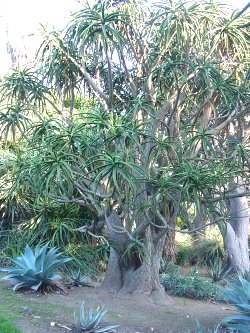Aloes of the
Huntington Gardens
Photos by Michael L. Charters
 |
 |
 |
| The Huntington Gardens in Pasadena maintains
one of the largest and finest collections of aloes outside of Africa.
The succulent genus Aloe is native to Africa, ranging from the
Cape Province of South Africa to Madagascar, the Arabian peninsula and
islands off the coast of Africa. The APG II system of plant classification
published in 2003 by the Angiosperm
Phylogeny Group places the genus in the family Asphodelaceae,
a placement which is reflected by the Plants
of Southern Africa Checklist, however the International
Plant Names Index still lists aloes as being in the lily family
(Liliaceae), and this is apparently still more widely accepted. Some authorities
have also placed it in a family of its own, the Aloaceae. Most aloes are
characterized by thick, fleshy leaves and yellow to red tubular flowers
on leafless stems. Some aloes are stemless with the rosettes growing at
ground level, while others produce a tall stalk either branched or unbranched
which may become treelike. Aloe species are frequently grown as garden
plants and many are highly prized by succulent collectors. They have been
known for a long time to have medicinal qualities most particularly for
external usage, and their antiseptic and antibiotic properties have been
particularly noted. Their utilization in internal and alternative medicines
has however been less well documented. Aloes have become well adapted
to harsh climates, and can thrive in many different types of habitats
such as mountains, grasslands, deserts and beaches. They propagate vegetatively
and by wind dispersal. There are between 300 and 400 species in Africa
and adjacent regions, with 170 species in South Africa alone. Aloes are
often confused with agaves, but the latter have fibrous leaves. The genus
name Aloe was assigned by Linnaeus in 1753, however the plant has
been known for thousands of years, featuring in bushman rock art and being
familiar to the Greeks as early as 300 B.C. I have read that the name
Aloe is derived from the Greek alsos referring to the bitter
sap of the leaves, and that this name probably derives either from the
Arabic alloeh or the Hebrew allal both meaning 'bitter.'
Due to recent taxonomic changes, a number of plants which are signed as
separate species at the Huntington Gardens have been grouped together
under one species name, and this is indicated in the descriptive text.
Some of the names listed below will as a result eventually disappear as
separate species name. This website is limited strictly to the genus Aloe, and does not include any of the other common aloe-like African succulents such as Gasteria, Bulbine, Kniphofia, and Haworthia. I have at least some photos of all of the 117 species listed below and will be adding them to the site as well as botanical information as time goes on. |
| Aloe
aculeata Aloe acutissima Aloe affinis Aloe africana Aloe alooides Aloe andongensis Aloe angelica Aloe arborescens (= A. mutabilis) Aloe aristata Aloe babatiensis Aloe ballii Aloe barbarae (= A. bainesii) Aloe bellatula Aloe berhana Aloe branddraaiensis Aloe brevifolia Aloe broomii Aloe buhrii Aloe bulbillifera Aloe burgerfortensis Aloe bussei Aloe cameronii Aloe camperi Aloe castanea Aloe chabaudii Aloe ciliaris Aloe classenii Aloe comptonii Aloe conifera Aloe cremnophila Aloe cryptopoda Aloe cyrtophylla Aloe descoingsii Aloe dichotoma Aloe diolii Aloe divaricata Aloe dolomitica Aloe dorotheae Aloe dyeri Aloe elgonica Aloe ellenbeckii Aloe esculenta Aloe excelsa Aloe ferox (= A. candelabrum) Aloe fibrosa |
Aloe fleurentinorum Aloe fosteri Aloe framesii Aloe gariepensis Aloe gerstneri Aloe glauca Aloe globuligemma Aloe gracilis Aloe graminicola Aloe greatheadii (= A. daveyana, A. barbertoniae, A. verdoorniae) Aloe greenii Aloe harlana Aloe hendrickxii Aloe hereroensis Aloe hildebrantdtii Aloe humilis Aloe imalotensis Aloe intermedia Aloe isaloensis Aloe jacksonii Aloe jucunda Aloe juvenna Aloe karasbergensis Aloe khamiesensis Aloe krapohliana Aloe krausii Aloe lateritia Aloe lineata Aloe littoralis Aloe longistyla Aloe lutescens Aloe macroclada Aloe marlothii (= A. spectabilis) Aloe massawana Aloe megalacantha Aloe melanacantha Aloe microstigma Aloe millotii Aloe mudenensis Aloe nobilis Aloe ortholopha Aloe parvibracteata |
Aloe parvula Aloe peglerae Aloe percrassa Aloe petricola Aloe petrophila Aloe pictifolia Aloe plicatilis Aloe pluridens Aloe porphyrostachys Aloe pratensis Aloe prinslooi Aloe rabaiensis Aloe rauhii Aloe reitzii Aloe rivae Aloe rivieri Aloe rubroviolacea Aloe sabaea Aloe saponaria Aloe schomeri Aloe secundiflora Aloe sinkatana Aloe somaliensis Aloe speciosa Aloe striata Aloe succotrina Aloe suffulta Aloe suprafoliata Aloe suzannae Aloe swynnertonii Aloe tenuior Aloe tomentosa Aloe tororoana Aloe ukambensis Aloe vacillans Aloe vanbalenii Aloe vaombe Aloe verdoorniae Aloe virens Aloe vogtsii Aloe wickensii Aloe X principis Aloe zebrina (=A. ammophila, A. transvaalensis) |
Reference material
© M.L. Charters, Sierra Madre, CA. 2007
The photographs contained in this website may not be reproduced without the express consent of the author.
Website Home Page